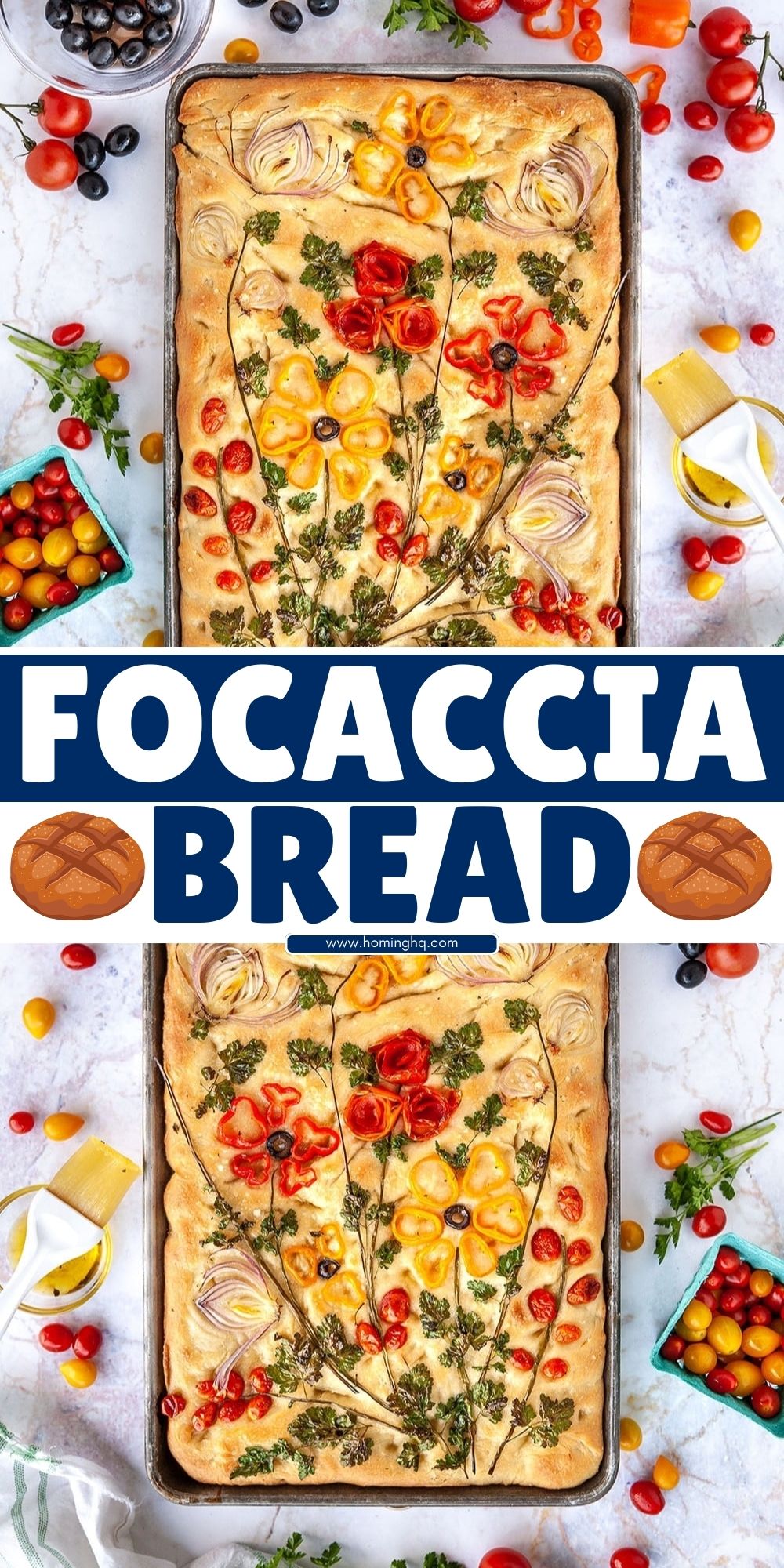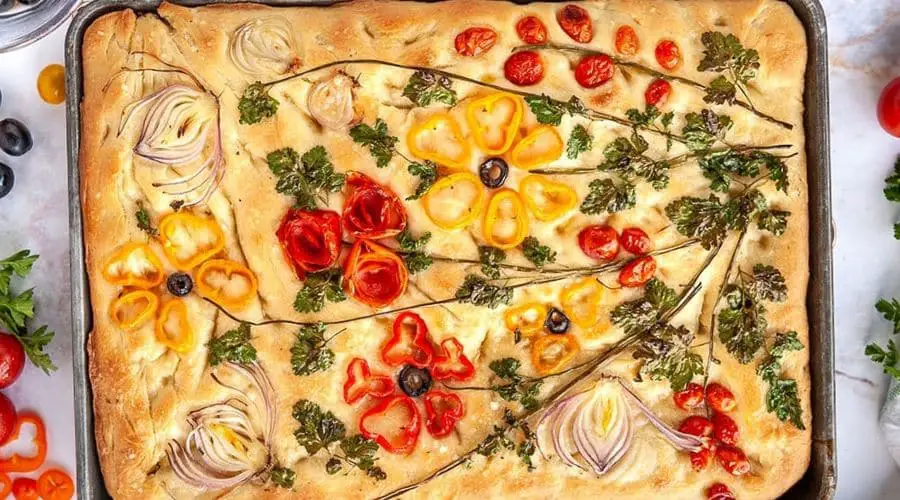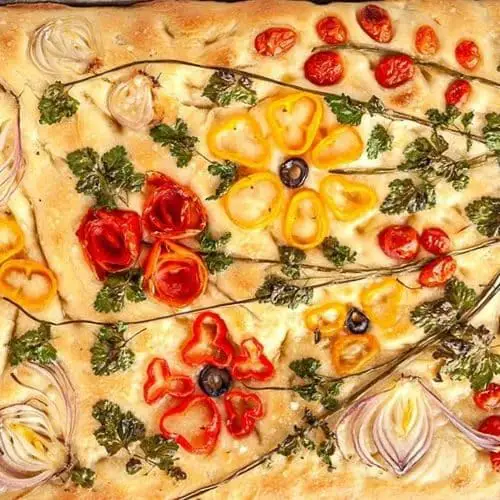Every product is independently reviewed and selected by our editors. If you buy something through our links, we may earn an affiliate commission at no extra cost to you.
Focaccia bread is a traditional Italian flatbread known for its crisp crust and soft, airy interior.
It has been a staple in Italian cuisine for centuries, with origins tracing back to ancient Rome.
This bread is incredibly versatile and can be enjoyed on its own or used as a base for sandwiches and appetizers.
Its signature dimples, created by pressing fingers into the dough before baking, help trap flavorful olive oil and seasonings.
With just a few simple ingredients, you can make bakery-quality focaccia in your own kitchen.

Why You’ll Love This Recipe
This focaccia bread recipe is easy to follow, making it perfect for both beginners and experienced bakers.
You don’t need any special equipment—just a mixing bowl, a baking sheet, and your hands.
The dough requires minimal kneading, relying on long fermentation to develop a rich, complex flavor.
You can customize it with your favorite herbs, cheeses, or vegetables to create a unique flavor combination.
It pairs wonderfully with soups, salads, or dipping oils, making it a great addition to any meal.
Ingredients for Homemade Focaccia Bread
Basic Ingredients
Flour – All-purpose or bread flour works best for a chewy yet airy texture.
Yeast – Instant or active dry yeast helps the dough rise and develop its structure.
Water – Warm water activates the yeast and hydrates the flour.
Salt – Enhances the flavor and strengthens the dough.
Olive Oil – Adds moisture, richness, and a classic Mediterranean taste.
Optional Toppings
Fresh herbs like rosemary, thyme, or basil add fragrance and flavor.
Minced garlic gives the bread a deep, savory taste.
Cherry tomatoes or olives provide bursts of sweetness and saltiness.
Parmesan or mozzarella creates a crispy, cheesy crust.
Flaky sea salt enhances the overall taste and texture.
Step-by-Step Instructions to Make Focaccia Bread

1. Preparing the Dough
In a large mixing bowl, combine warm water and yeast.
Let it sit for a few minutes until it becomes foamy, which indicates the yeast is activated.
Add flour, salt, and olive oil to the bowl, then mix until a shaggy dough forms.
Use your hands or a wooden spoon to incorporate the ingredients until no dry spots remain.
2. First Rise: Letting the Dough Develop Flavor
Cover the bowl with a clean kitchen towel or plastic wrap.
Let the dough rise at room temperature for 1 to 2 hours, or until it doubles in size.
For a deeper flavor, refrigerate the dough overnight and let it ferment slowly.
3. Shaping and Preparing the Dough for Baking
Drizzle olive oil onto a baking sheet or pan to prevent sticking and enhance flavor.
Gently stretch and spread the dough to fit the pan, being careful not to deflate it too much.
Use your fingers to press deep dimples all over the surface, which helps trap the olive oil and toppings.
Brush the top with more olive oil and sprinkle with salt, herbs, or any desired toppings.
4. Second Rise: Ensuring a Light and Fluffy Texture
Cover the pan and let the dough rest for another 30 to 45 minutes.
This second rise allows the gluten to relax, creating a softer, airier texture.
Preheat the oven while waiting to ensure it’s at the right temperature for baking.
5. Baking to Perfection
Set the oven to 425°F (220°C) and place the pan in the center rack.
Bake for 20 to 25 minutes, or until the focaccia is golden brown and crispy on the edges.
Let it cool slightly before slicing to allow the flavors to settle.
Serve warm with olive oil, balsamic vinegar, or your favorite toppings.
Variations and Flavor Enhancements
Classic Rosemary and Sea Salt Focaccia
This is the most traditional version of focaccia, featuring fresh rosemary and flaky sea salt.
The rosemary infuses the bread with a fragrant, earthy aroma, while the salt enhances its flavor.
A generous drizzle of olive oil before baking gives it a rich and crispy crust.
Garlic and Parmesan Focaccia
Minced garlic adds a deep, savory taste that pairs perfectly with the bread’s soft texture.
Parmesan cheese sprinkled over the top creates a crispy, golden crust with a nutty flavor.
This variation is great as a side for pasta or served with marinara sauce for dipping.
Sun-Dried Tomato and Olive Focaccia
Sun-dried tomatoes add a hint of sweetness and a slightly chewy texture.
Black or green olives provide a salty contrast that balances the bread’s mild taste.
This combination works well as a stand-alone appetizer or alongside Mediterranean dishes.
Sweet Focaccia with Honey and Fruit
For a unique twist, swap out the savory toppings for a lightly sweetened version.
Drizzle honey over the dough and top with sliced figs, apples, or berries.
A sprinkle of cinnamon or nuts adds extra depth and crunch to this dessert-style focaccia.
Troubleshooting Common Focaccia Issues
Why is My Focaccia Too Dense or Dry?
If the bread is too dense, the dough may not have risen long enough.
Make sure to allow enough proofing time for the yeast to develop air pockets.
Using too much flour or not enough water can also lead to a dry texture.
What If My Dough Won’t Rise?
Check that your yeast is fresh and active by proofing it in warm water before mixing.
Cold temperatures slow down fermentation, so let the dough rise in a warm, draft-free area.
If refrigerating overnight, allow the dough to come to room temperature before baking.
How Do I Prevent a Soggy or Overly Crispy Texture?
If the bottom is too soggy, the baking sheet may not have been preheated properly.
Baking at too low a temperature can also prevent proper browning, making the bread too soft.
For an extra crispy crust, bake the focaccia on a preheated pizza stone or a dark metal pan.
Final Thoughts
Making homemade focaccia bread is a rewarding and delicious experience.
With its crisp golden crust, airy interior, and endless topping possibilities, it’s a versatile bread that can be enjoyed in many ways.
By following the step-by-step process and troubleshooting tips, you can achieve bakery-quality results at home.
Don’t be afraid to experiment with different herbs, cheeses, and flavor combinations to make it your own.
Whether served as a side dish, a sandwich base, or simply dipped in olive oil, focaccia is a timeless classic worth mastering.
Frequently Asked Questions
1. Can I Make Focaccia Without Yeast?
Traditional focaccia relies on yeast for its airy texture, but you can use baking powder or sourdough starter as an alternative.
However, yeast-free versions may have a denser texture and won’t develop the same depth of flavor.
2. How Long Does Focaccia Bread Last?
Fresh focaccia is best enjoyed the same day, but it can be stored in an airtight container at room temperature for up to two days.
For longer storage, refrigerate it for up to a week or freeze it for up to three months.
3. Can I Freeze Focaccia Bread?
Yes, you can freeze focaccia after it has cooled completely.
Wrap it tightly in plastic wrap and place it in a freezer-safe bag to prevent freezer burn.
Reheat in the oven at 350°F (175°C) for 10 to 15 minutes to restore its texture.
4. Why Did My Focaccia Turn Out Too Oily?
Focaccia requires a good amount of olive oil, but too much can make it greasy instead of crisp.
Use high-quality olive oil and brush it evenly rather than drenching the dough.
If your focaccia feels overly oily after baking, let it cool on a wire rack to prevent excess absorption.
5. Can I Make Focaccia in Advance?
Yes, you can prepare the dough a day ahead and let it rise slowly in the refrigerator overnight.
This extended fermentation improves the flavor and texture of the bread.
Simply bring the dough to room temperature, shape it, and proceed with baking as usual.

Focaccia Bread
Equipment
- 1 large mixing bowl
- 1 wooden spoon or silicone spatula
- 1 measuring cup
- 1 Set of Measuring Spoons
- 1 baking sheet (9×13-inch)
- 1 pastry brush (optional, for oiling)
- 1 Wire cooling rack
Ingredients
Dough:
- 3 ½ cups 440g all-purpose flour or bread flour
- 2 teaspoons salt
- 1 packet 2 ¼ teaspoons instant or active dry yeast
- 1 ⅓ cups 320ml warm water (about 110°F/45°C)
- ¼ cup 60ml extra virgin olive oil
Toppings:
- 2 tablespoons olive oil for drizzling
- 1 teaspoon flaky sea salt
- 1 tablespoon fresh rosemary leaves or dried rosemary
Instructions
Step 1: Activate the Yeast
- In a large mixing bowl, combine warm water and yeast.
- Let it sit for 5 to 10 minutes until it becomes foamy, indicating the yeast is active.
Step 2: Mix the Dough
- Add flour, salt, and olive oil to the yeast mixture.
- Stir with a wooden spoon or spatula until a sticky dough forms.
Step 3: First Rise
- Cover the bowl with a clean kitchen towel or plastic wrap.
- Let the dough rise at room temperature for 1 to 2 hours, or until it doubles in size.
- For enhanced flavor, refrigerate overnight and allow a slow fermentation.
Step 4: Prepare the Baking Sheet
- Drizzle olive oil onto a 9×13-inch baking sheet, ensuring the surface is well coated.
- Transfer the risen dough onto the oiled sheet.
Step 5: Shape and Dimple the Dough
- Gently stretch the dough to fit the pan, being careful not to deflate it too much.
- Use your fingers to press deep dimples across the surface.
Step 6: Second Rise
- Cover and let the dough rest for 30 to 45 minutes to allow additional rising.
- Meanwhile, preheat the oven to 425°F (220°C).
Step 7: Add Toppings and Bake
- Drizzle olive oil over the dough and sprinkle with sea salt and rosemary.
- Bake for 20 to 25 minutes until golden brown and crispy on the edges.
Step 8: Cool and Serve
- Transfer the focaccia to a wire rack and let it cool slightly before slicing.
- Enjoy warm with olive oil, balsamic vinegar, or as a side dish.
Notes
- For extra crispy focaccia: Bake on the lowest oven rack or preheat a pizza stone before placing the baking sheet on top.
- For a fluffier texture: Allow the dough to rise for a longer time, especially during the first proof.
- Storage: Store at room temperature in an airtight container for up to 2 days. Reheat in the oven for best results.
- Freezing: Wrap cooled focaccia in plastic wrap and store in a freezer-safe bag for up to 3 months. Reheat in a 350°F (175°C) oven for 10-15 minutes.
- Flavor variations: Try adding sun-dried tomatoes, olives, or caramelized onions for unique flavor twists.

